Gonatus oregonensis
F. G. Hochberg and Richard E. YoungIntroduction
Gonatus oregonensis is known only from young squid of 46 mm ML or less and has only been reported from the general region of the type locality.
Diagnosis
A Gonatus with ...
- more than 4 sucker series throughout club dactylus.
Characteristics

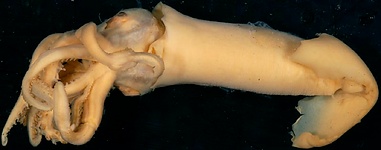
Figure. Ventral view of Gonatus oregonensis, holotype, 39 mm ML. Photograph by R. Young.
- Arms
- Arm lengths 59-63% of the ML at 46 mm ML.
- Number of suckers in proximal half of each arm IV at 46 mm ML = 47.
- Arm lengths 59-63% of the ML at 46 mm ML.
- Tentacles
- Tentacular club 21-30% of ML.
- Club dactylus with 7-8 irregular series at proximal end, decreasing to 5 or 6 series at the end of the dactylus.
- Club ventral-marginal zone with 4-5 series of suckers in central region; medial suckers ca. one-half diameter of suckers of marginal series (holotype).
- Club dorsal-marginal zone with 3-4 irregular series dorsal to large central hook (holotype).
- Club medial zone with large central hook; medium (ca. half size of central hook) distal hook and proximal series with usually 4 small hooks followed proximally by usually 2 suckers (46 mm ML).
- Total number of suckers (excluding terminal pad and medial zone) on tentacular club: 295-370.
- Median region of tentacular stalk between marginal series with ca. 70 scattered suckers (46 mm ML); in 24 mm ML squid stalk suckers in 6, somewhat irregular, alternating rows.
 Click on an image to view larger version & data in a new window
Click on an image to view larger version & data in a new window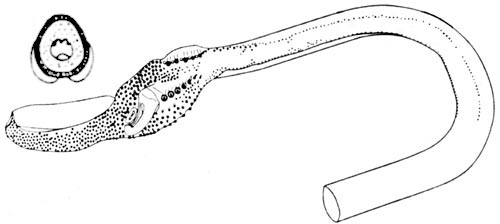
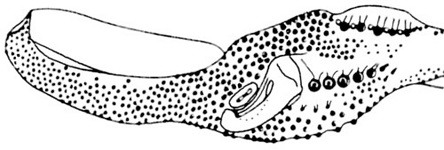

Figure. Oral views of the tentacle and some club suckers of G. oregonensis, 46 mm ML. Top - Tentacle and dactylus sucker. Middle - Tentacular club (enlargement from above drawing). Bottom - Proximal hooks and suckers of the medial zone of the tentacular club (enlargement from above drawing). Drawings from Jefferts (1985).
- Photophores absent
Comments
The above description, except for photographs and characters annotated with "holotype", is taken from Jefferts (1985). More details of the description can be found here.
Jefferts finds G. oregonensis similar to G. californiensis but differing in fin size, number of club suckers and distribution of suckers on the dactylus.
We have compared the holotype side by side with two specimens of G. californiensis of about the same size as the holotype. The two species are very similar but the differences noted by Jefferts seem to hold true. We have also noted that the arm hooks of G. oregonensis are distinctly larger than those of the G. californiensis examined. However, until larger specimens are found and intraspecific variation is better understood, the validity of this species must retain an element of doubt.
Life History
From Jefferts (1985):- Arm hooks develop at 24-30 mm ML.
- Central and distal club hooks develop at 24-30 mm ML.
- Proximal club hooks develop at 35-39 mm ML; sucker nearest the central hook is the first of proximal series to become a hook.
Distribution
Type locality: Northeast Pacific at 44°39'N, 128°22'W off the Oregon coast. G. oregonensis is known only from waters off Oregon.References
Jefferts, K. 1985. Gonatus ursabrunae and Gonatus oregonensis, Two New Species of Squids from the Northeastern Pacific Ocean (Cephalopoda: Oegopsida: Gonatidae). Veliger, 28(2):159-174.
Okutani, T., T. Kubodera and K. Jefferts. 1983. Diversity, distribution and ecology of gonatid squids in the subarctic Pacific: A review. Bull. Ocean Res. Inst., Univ. Tokyo, No. 26 (1):150-192.
About This Page
F. G. Hochberg

Santa Barbara Museum of Natural History, Santa Barbara, California, USA

University of Hawaii, Honolulu, HI, USA
Page copyright © 2016 F. G. Hochberg and
All Rights Reserved.
- First online 31 May 2006
- Content changed 31 May 2006
Citing this page:
Hochberg, F. G. and Richard E. Young. 2006. Gonatus oregonensis . Version 31 May 2006. http://tolweb.org/Gonatus_oregonensis/19775/2006.05.31 in The Tree of Life Web Project, http://tolweb.org/





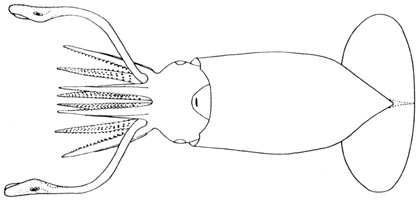

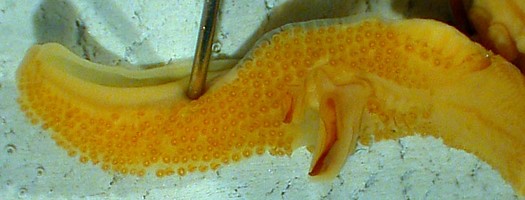
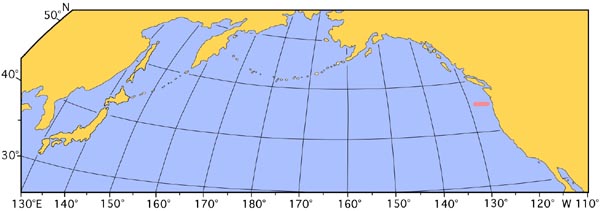



 Go to quick links
Go to quick search
Go to navigation for this section of the ToL site
Go to detailed links for the ToL site
Go to quick links
Go to quick search
Go to navigation for this section of the ToL site
Go to detailed links for the ToL site